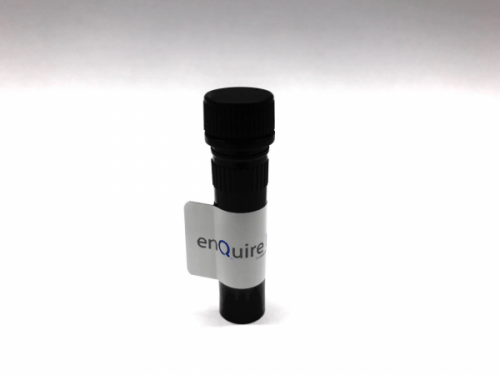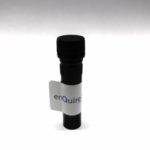Human CSNK2A1 / CK2A1 Recombinant Protein Product Attributes
Product Type: Recombinant Protein
Recombinant CSNK2A1 / CK2A1 based upon sequence from: Human
Host: QP7491 protein expressed in E. coli.
Tag: His-SUMO
Protein Construction: A DNA sequence encoding the Homo sapiens (Human) CSNK2A1 / CK2A1, was expressed in the hosts and tags indicated. Please select your host/tag option, above.
Application Notes: Please contact us for application specific information for QP7491.
Bioactivity Data: Untested
Full Length? Partial (see sequence information for more details).
Expression Region: Arg8 – Asn350
Amino Acid Sequence: RARVYTDVNT HRPREYWDYE SHVVEWGNQD DYQLVRKLGR GKYSEVFEAI NITNNEKVVV KILKPVKKKK IKREIKILEN LRGGPNIITL ADIVKDPVSR TPALVFEHVN NTDFKQLYQT LTDYDIRFYM YEILKALDYC HSMGIMHRDV KPHNVMIDHE HRKLRLIDWG LAEFYHPGQE YNVRVASRYF KGPELLVDYQ MYDYSLDMWS LGCMLASMIF RKEPFFHGHD NYDQLVRIAK VLGTEDLYDY IDKYNIELDP RFNDILGRHS RKRWERFVHS ENQHLVSPEA LDFLDKLLRY DHQSRLTARE AMEHPYFYTV VKDQARMGSS SMPGGSTPVS SAN
Purity: Greater than 90% as determined by SDS-PAGE.
Reconstitution Instructions:
Concentration of Human CSNK2A1 / CK2A1 Protein:
Endotoxin Levels: Not determined.
Buffer: Tris-based buffer, 50% glycerol
Storage Conditions: Store at -20C to -80C.
| Recombinant Human CSNK2A1 / CK2A1 Protein (8-350aa) General Information | |
|---|---|
| Alternate Names | |
| CSNK2A1; CK2A1; CKII; CK2A1; CSNK2A3; OCNDS | |
| Curated Database and Bioinformatic Data | |
| Gene Symbol | CSNK2A2 |
| Entrez Gene ID | 1457 |
| Ensemble Gene ID | ENSG00000101266 |
| RefSeq Protein Accession(s) | NP_001886.1 |
| RefSeq mRNA Accession(s) | NM_001895.3, NM_177559.2, NM_177560.2 |
| UniProt ID(s) | P68400 |
| UniGene ID(s) | Hs.644056 |
| HGNC ID(s) | HGNC:2457 |
| COSMIC ID Link(s) | CSNK2A1 |
| KEGG Gene ID(s) | hsa:1457 |
| PharmGKB ID(s) | PA26957 |
| General Description of Recombinant Human CSNK2A1 / CK2A1 Protein (8-350aa). | |
| Catalytic subunit of a constitutively active serine/threonine-protein kinase complex that phosphorylates a large number of substrates containing acidic residues C-terminal to the phosphorylated serine or threonine. Regulates numerous cellular processes, such as cell cycle progression, apoptosis and transcription, as well as viral infection. May act as a regulatory node which integrates and coordinates numerous signals leading to an appropriate cellular response. During mitosis, functions as a component of the p53/TP53-dependent spindle assbly checkpoint (SAC) that maintains cyclin-B-CDK1 activity and G2 arrest in response to spindle damage. Also required for p53/TP53-mediated apoptosis, phosphorylating ‘Ser-392’ of p53/TP53 following UV irradiation. Can also negatively regulate apoptosis. Phosphorylates the caspases CASP9 and CASP2 and the apoptotic regulator NOL3. Phosphorylation protects CASP9 from cleavage and activation by CASP8, and inhibits the dimerization of CASP2 and activation of CASP8. Regulates transcription by direct phosphorylation of RNA polymerases I, II, III and IV. Also phosphorylates and regulates numerous transcription factors including NF-kappa-B, STAT1, CREB1, IRF1, IRF2, ATF1, SRF, MAX, JUN, FOS, MYC and MYB. Phosphorylates Hsp90 and its co-chaperones FKBP4 and CDC37, which is essential for chaperone function. Regulates Wnt signaling by phosphorylating CTNNB1 and the transcription factor LEF1. Acts as an ectokinase that phosphorylates several Extracellular domain proteins. During viral infection, phosphorylates various proteins involved in the viral life cycles of EBV, HSV, HBV, HCV, HIV, CMV and HPV. Phosphorylates PML at ‘Ser-565’ and primes it for ubiquitin-mediated degradation. Plays an important role in the circadian clock function by phosphorylating ARNTL/BMAL1 at ‘Ser-90’ which is pivotal for its interaction with CLOCK and which controls CLOCK nuclear entry. | |
Limitations and Performance Guarantee
This is a life science research product (for Research Use Only). This product is guaranteed to work for a period of two years when stored at -70C or colder, and one year when aliquoted and stored at -20C.





There are no reviews yet.